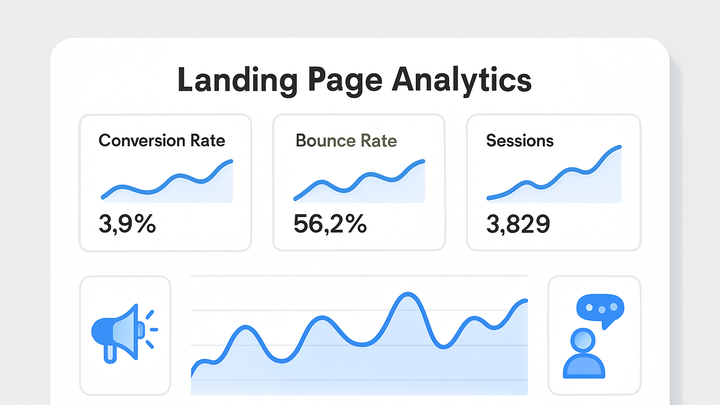Published on 2025-06-26T04:46:23Z
What is a Landing Page? Examples of Landing Pages
Landing pages are standalone web pages designed specifically for marketing or advertising campaigns, guiding visitors towards a single, clearly defined objective. Unlike general website pages, they remove navigational distractions and focus on conversion-centric elements such as forms, calls-to-action (CTAs), or product information. In analytics, landing pages serve as the first interaction point for visitors arriving via paid ads, email links, social media promotions, or organic search results. Monitoring landing page performance allows marketers to assess the effectiveness of campaigns, understand visitor behavior, and optimize user experience for higher conversion rates. Tools like Google Analytics 4 (GA4) and PlainSignal enable precise tracking of key metrics—such as conversion rate, bounce rate, and session duration—without compromising user privacy. By analyzing this data, teams can iterate on design, messaging, and targeting strategies to boost overall campaign ROI.
Landing page
Landing pages are focused web pages designed for specific campaigns to drive and measure visitor conversions.
Definition and Purpose
This section explains what landing pages are and why they matter in analytics-driven marketing.
-
Standalone campaign pages
Landing pages are built to host targeted marketing campaigns independent of the main site’s navigation, ensuring visitors focus on a single message.
-
Conversion goals
They focus on a single objective, such as capturing email leads, driving sign-ups, or selling a specific product.
-
Lead generation
Collecting user information via forms in exchange for content or offers.
-
E-commerce sales
Encouraging visitors to make a purchase on a dedicated product or offer page.
-
Key Metrics for Landing Pages
Landing page analytics relies on specific performance indicators to evaluate visitor engagement and conversion efficiency.
-
Conversion rate
The percentage of visitors who complete the desired action on the landing page.
-
Bounce rate
The percentage of single-page sessions where users leave without any interaction.
-
Average session duration
The average time visitors spend on your landing page during a session.
Tracking Landing Pages with Analytics Tools
Analytics platforms enable you to collect, visualize, and act on data about how users arrive at and interact with your landing pages.
-
Google analytics 4 (GA4)
GA4 uses an event-based model to track landing page sessions and conversions. To implement, add the global site tag to your page header and configure conversion events in the GA4 interface.
-
PlainSignal (cookie-free analytics)
PlainSignal offers privacy-focused tracking without cookies. Include the following snippet before closing </head> to begin collecting landing page metrics:
-
Example tracking code
<link rel="preconnect" href="//eu.plainsignal.com/" crossorigin /> <script defer data-do="yourwebsitedomain.com" data-id="0GQV1xmtzQQ" data-api="//eu.plainsignal.com" src="//cdn.plainsignal.com/plainsignal-min.js"></script>
-
Best Practices for Landing Page Analytics and Optimization
Follow these guidelines to ensure accurate measurement and continuous improvement of your landing pages.
-
Define clear goals
Establish specific, measurable objectives—such as lead submissions or sales—to guide your analytics setup.
-
Use utm parameters
Tag campaign URLs with UTM parameters to segment traffic sources and evaluate campaign performance.
-
Implement a/b testing
Experiment with different headlines, CTAs, and designs to identify the highest-performing combinations.
-
Monitor and iterate
Regularly review analytics insights to refine messaging, layout, and targeting for continuous conversion improvements.
